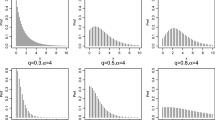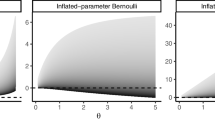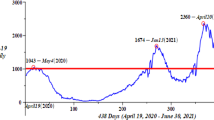Abstract
This paper develops a Bayesian semiparametric quantile regression model for count data. The count responses are converted to continuous responses through the “jittered” method and a transform function. A Bayesian semiparametric quantile regression modeling approach is then developed. The error distribution in the quantile regression model is assumed to be a mixture of asymmetric Laplace distributions constructed with Dirichlet process. Historical death tolls of China caused by earthquakes from 1969 to 2006 are used for fitting, and a parametric model is employed for model comparison. The results of model comparison show that the proposed semiparametric quantile regression model outperforms the parametric model. The empirical analysis illustrates that the impact of earthquake magnitude on death tolls is significant. Moreover, the impact of the magnitude is more pronounced on higher percentiles of death tolls.






Similar content being viewed by others
References
Badal J, Vázquez-Prada M, González A (2005) Priliminary quantitative assessment of earthquake casualties. Nat Hazards 34:353–374
Bali T (2003) The generalized extreme value distribution. Econ Lett 79:423–427
Balkema A, de Haan L (1974) Residual life time at great age. Ann Prob 2:792–804
Beckett S, Jee J, Ncube T, Pompilus S, Washinton Q, Singh A, Pal N (2014) Zero-inflated poisson (zip) distribution: parameter estimation and applications to model data from natural calamities. J Risk Insur 6:751–767
Bernardi M, Gayraud G, Petrella L (2015) Bayesian tail risk interdependence using quantile regression. Bayesian Anal 10(3):553–603
Bohning D (1998) Zero-inflated poisson models and CA man: a tutorial collection of evidence. Biomet J 40:833–843
Boucher J, Denuit M, Guillen M (2009) Number of accidents or number of claims? An approach with zero-inflated poisson models for panel data. J Risk Insur 76(4):821–846
Chernozhukov V, Hansen C (2006) Instrumental quantile regression inference for structural and treatment effect models. J Econom 132(2):491–525
Cheung Y (2002) Zero-inflated models for regression analysis of count data: a study of growth and development. Stat Med 21:1461–1469
Coles S (2001) An introduction to statistical modeling of extreme values. Springer, New York
Czajkowski J, K S, D S (2011) An analysis of coastal and inland fatalities in landfalling US hurricanes. Nat Hazards 59:1513–1531
Fernandes W, NaghettiniM Loschi R (2010) A Bayesian approach for estimating extreme flood probabilities with upper-bounded distribution functions. Stoch Environ Res Risk Assess 24(8):1127–1143
Fuzi MFM, Jemain AA, Noriszura I (2016) Bayesian quantile regression model for calim count data. Insur Math Econ 66:124–137
Gelfand A, Kottas A, MacEachern S (2005) Bayesian nonparametric spatial modeling with Dirichlet process mixing. J Am Stat Assoc 100(471):1021–1035
Gutiérrez E, Taucer F, Groeve T, Al-Khudhairy D, Zaldivar J (2005) Analysis of worldwide earthquake mortality using multivariate demographic and seismic data. Am J Epidemiol 161:1151–1158
Ibrahim J, Chen M, Sinha D (2001) Criterion-based methods for Bayesian model assessment. Stat Sin 11:419–443
Ishwaran H, Zarepour M (2002) Dirichlet prior sieves in finite normal mixtures. Stat Sin 12:941–963
Karlis D, Ntzoufras I (2003) Analysis of sports data using bivariate Poisson models. J R Stat Soc D 52:381–393
Karlis D, Ntzoufras I (2006) Bayesian analysis of the differences of count data. Stat Med 25:1885–1905
Koenker R (2005) Quantile regression. Cambridge University Press, Cambridge
Koenker R, Bassett G (1978) Regression quantiles. Insur Econom 46:33–50
Koenker R, Zhao Q (1996) Conditional quantile estimation and inference for arch models. Econom Theory 12:793–813
Kottas A, Krnjajić (2009) Bayesian semiparametric modelling in quantile regression. Scand J Stat 36:297–319
Lee M (1992) Median regression for ordered discrete response. J Econom 51:59–77
Lee D, Neocleous T (2010) Bayesian quantile regression for count data with application to environmental epidemiology. J R Stat Soc Ser C 59(5):905–920
Li L, Wang J, Leung H, Zhao S (2012a) A Bayesian method to mine spatial data sets to evaluate the vulnerability of human beings to catastrophic risk. Risk Anal 32(6):1072–92
Li Y, Yutaka K, Pan J, Song X (2012b) A criterion-based model comparison statistic for structural equation models with heterogeneous data. J Multivar Anal 112:92–107
Li Y, Tang N, Jiang X (2016) Bayesian approaches for analyzing earthquake catastrophic risk. Insur Math Econ 68:110–119
Machado J, Silva J (2005) Quantiles for counts. J Am Stat Assoc 100(472):1226–1237
Pickands J (1975) Statistical inference using extreme order statistics. Ann Stat 3:119–131
Pitt D (2006) Regression quantile analysis of claim termination rates for income protection insurance. Ann Actuar Sci 1(II):345–357
Powell J (1984) Least absolute deviation estimation for the censored regression model. J Econom 25:303–325
Powell J (1986) Censored regression quantiles. J Econom 32:143–155
Sethuraman J (1994) A constructive definition of Dirichlet priors. Stat Sin 4:639–650
Smith RL (2003) Statistics of extremes with applications in environment, insurance and finance. University of North Carolina, Chapel Hill
Turkan S, Özel G (2014) Modelling destructive earthquake casualties based on a comparative study for Turkey. Nat Hazards 72:1093–1110
Yip K, Yau K (2005) On modeling claim frequency data in general insurance with extra zeros. Insur Math Econom 36(2):153–163
Yu K, Moyeed R (2001) Bayesian quantile regression. Stat Probab Lett 54:437–447
Author information
Authors and Affiliations
Corresponding author
Additional information
The authors are grateful to the editor and the reviewers for their valuable comments and suggestions. This research is supported by National Social Science Fund of China No. 13CTJ002 and No. 16ZDA052, National Natural Science Fund of China No. 11501294 and No. 11871263, Natural Science Foundation of Guangdong Province of China No. 2016A030313856, Shenzhen Sci-Tech Fund No. JCYJ20170307110329106, and Jiangsu Qinglan Project (2017).
Rights and permissions
About this article
Cite this article
Jiang, X., Li, Y., Yang, A. et al. Bayesian semiparametric quantile regression modeling for estimating earthquake fatality risk. Empir Econ 58, 2085–2103 (2020). https://doi.org/10.1007/s00181-018-1615-4
Received:
Accepted:
Published:
Issue Date:
DOI: https://doi.org/10.1007/s00181-018-1615-4




